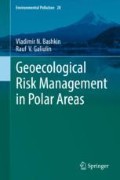Abstract
This chapter considers the peculiarities of human exposure to chemicals in the gas industry, such as methane, hydrogen sulfide, gas condensate, methanol, surfactants, and natural gas combustion products in the forms of carbon and nitrogen oxides, sulfur dioxide, and benz(a)pyrene, as well as oil and heavy metals. It has been shown that the risk of exposure of the human body to chemicals that are emitted in the gas industry can be controlled by using sanitary–hygienic standards in the form of the maximum permissible concentration (MPC), temporarily permissible concentration (TPC), maximum permissible level (MPL), and remote control developed for air, soil, water, wastewater, and the skin of the hands.
Access this chapter
Tax calculation will be finalised at checkout
Purchases are for personal use only
References
Bashkin, V. N., Galiulin, R. V., Barsukov, P. A., & Arabsky, A. K. (2017c). Biogeochemical technologies for managing pollution in polar ecosystems (Vol. 26, pp. 19–34). Cham: Springer.
Boev, V. M., & Setko, N. P. (2001). Sulphurous compounds of natural gas and their action on an organism. Moscow: Meditsina. 216 pp
Galiulin, R. V., & Bashkin, V. N. (2018). Innovative green technologies in the gas industry. In M. Radosavljević (Ed.), Challenges of green economy. International monograph (pp. 103–111). Beograd: Ecologica.
Galiulin, R. V., Bashkin, V. N., & Galiulina, R. A. (2017e). Risk management of the environmental pollution by methanol as the main inhibitor of hydrate formation in the gas industry of polar regions. In Ecological and biogeochemical cycling in impacted polar ecosystems (pp. 191–203). New York: Nova Science.
Galysheva, N. P. (1999). Monitoring of pollution of atmospheric air. Infor, 3, 29–40.
Grunvald, A. V. (2007). Growth of methanol consumption in the gas industry of Russia and the geoenvironmental risks arising at its use as hydrate formation inhibitor. Oilgas Business. 25 pp. http://www.ogbus.ru
Harmful substances in the industry. Organic substances. (1976). Leningrad: Khimiya, 1. 592 pp.
Harmful substances in the industry. Organic substances. (1985). Leningrad: Khimiya, 1. 464 pp.
Harmful chemical substances. Inorganic compounds of elements I–IV groups. (1988). Leningrad: Khimiya. 512 pp.
Harmful chemical substances. Inorganic compounds of elements V–VIII groups. (1989). Leningrad: Khimiya. 592 pp.
Harmful chemical substances. Hydrocarbons. Halogen derivatives of hydrocarbons. (1990). Leningrad: Khimiya. 732 pp.
Hydrogen sulfide. Hygienic criteria of state of environment. (1986). Geneva: WHO, 19. 51 pp.
Malyutina, N. N., & Taranenko, L. A. (2014). Pathophysiological and clinical aspects of impact of methanol and formaldehyde on a human organism. Modern Problems of Science and Education, 2, 1–11.
Mun, S. A., Larin, S. A., Brailovsky, V. V., Lodza, A. F., Zinchuk, S. F., & Glushkov, A. N. (2006). Benz(a)pyrene in atmospheric air and oncological morbidity in Kemerovo. Hygiene and Sanitation, 4, 28–30.
Putilova, A. A., & Blokhina, N. N. (2006). Natural and anthropogenic prerequisites and risk factors of malignant new growths. Issues of Regional Ecology, 6, 61–66.
Russian gas encyclopedia. (2004). Moscow: Bolshaya Rossiyskaya Entsyklopediya. 527 pp.
Serkovskaya, G. S. (2011). Content of benz-α-pyrene in samples of commodity oils. Chemistry and Technology of Fuels and Oils, 3, 56.
Zhurkina, O. V. (2007). Role of exogenous risk factors in development of cancer of kidney. News of the Samara Scientific Center of RAS, 2, 30–34.
Author information
Authors and Affiliations
Rights and permissions
Copyright information
© 2019 Springer Nature Switzerland AG
About this chapter
Cite this chapter
Bashkin, V.N., Galiulin, R.V. (2019). Risk of Human Exposure to Chemical Substances in the Gas Industry. In: Geoecological Risk Management in Polar Areas. Environmental Pollution, vol 28. Springer, Cham. https://doi.org/10.1007/978-3-030-04441-1_4
Download citation
DOI: https://doi.org/10.1007/978-3-030-04441-1_4
Published:
Publisher Name: Springer, Cham
Print ISBN: 978-3-030-04440-4
Online ISBN: 978-3-030-04441-1
eBook Packages: Earth and Environmental ScienceEarth and Environmental Science (R0)

